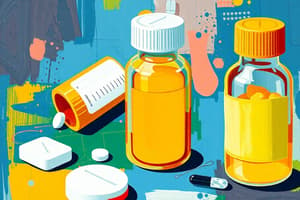Podcast
Questions and Answers
Which principle is crucial for ensuring safe drug administration?
Which principle is crucial for ensuring safe drug administration?
- Right side effects
- Right assessment (correct)
- Right documentation
- Right time
What is a recommended action if a patient is prescribed a new medication?
What is a recommended action if a patient is prescribed a new medication?
- Allow the patient to self-medicate without guidance
- Provide written instructions on how to administer the medication (correct)
- Educate the patient on dietary restrictions only
- Instruct the patient to discontinue all previous medications
What should be done if a patient has difficulty swallowing enteric-coated tablets?
What should be done if a patient has difficulty swallowing enteric-coated tablets?
- Administer the medication through an intravenous line
- Encourage the patient to drink a large amount of water (correct)
- Suggest the patient take the medication at bedtime instead
- Crush the tablet to make it easier to swallow
What is the fastest route of drug administration?
What is the fastest route of drug administration?
Which of the following is NOT one of the rights in medication administration?
Which of the following is NOT one of the rights in medication administration?
How should otic medications be administered for adults?
How should otic medications be administered for adults?
What action should a nurse take when uncertain about medication calculation?
What action should a nurse take when uncertain about medication calculation?
What consideration should be included in a patient's education about new medication?
What consideration should be included in a patient's education about new medication?
What does drug potency refer to?
What does drug potency refer to?
Which of the following statements best describes a drug's therapeutic index?
Which of the following statements best describes a drug's therapeutic index?
What is meant by 'maximal efficacy' in pharmacodynamics?
What is meant by 'maximal efficacy' in pharmacodynamics?
Which parameter indicates the time from drug administration to the first observable effect?
Which parameter indicates the time from drug administration to the first observable effect?
Which type of medication requires careful monitoring due to a narrow therapeutic index?
Which type of medication requires careful monitoring due to a narrow therapeutic index?
Which of the following factors can slow down drug absorption?
Which of the following factors can slow down drug absorption?
What is the primary site of drug metabolism in the body?
What is the primary site of drug metabolism in the body?
How does the presence of food in the stomach affect drug absorption?
How does the presence of food in the stomach affect drug absorption?
When considering pharmacokinetics, what is the primary concern during the drug distribution phase?
When considering pharmacokinetics, what is the primary concern during the drug distribution phase?
What is one effect of the first pass metabolism on oral medications?
What is one effect of the first pass metabolism on oral medications?
Which drug characteristic often leads to better absorption in the stomach?
Which drug characteristic often leads to better absorption in the stomach?
What term describes the time it takes for the amount of drug in the body to be reduced by half?
What term describes the time it takes for the amount of drug in the body to be reduced by half?
What happens to drug absorption in elderly patients due to changes in gastric conditions?
What happens to drug absorption in elderly patients due to changes in gastric conditions?
Which of these factors does NOT affect drug absorption?
Which of these factors does NOT affect drug absorption?
In which phase of pharmacokinetics does the kidney play a crucial role?
In which phase of pharmacokinetics does the kidney play a crucial role?
What is the primary effect of Diphenhydramine (Benadryl)?
What is the primary effect of Diphenhydramine (Benadryl)?
What is meant by the term 'potentiation' in drug interactions?
What is meant by the term 'potentiation' in drug interactions?
What is the duration of action for the drug mentioned in the content?
What is the duration of action for the drug mentioned in the content?
According to Clark's Rule, what will be the calculated dose for a child weighing 7 kg if the adult dose is 80 mg?
According to Clark's Rule, what will be the calculated dose for a child weighing 7 kg if the adult dose is 80 mg?
What typically causes an idiosyncratic reaction to a drug?
What typically causes an idiosyncratic reaction to a drug?
In Young's Rule, which variable is used to calculate the child's dose?
In Young's Rule, which variable is used to calculate the child's dose?
What is the additive effect in drug interactions?
What is the additive effect in drug interactions?
How does drug toxicity affect the human body?
How does drug toxicity affect the human body?
Which of the following best describes the term 'antagonistic' in drug interactions?
Which of the following best describes the term 'antagonistic' in drug interactions?
What are the two main parts of the nervous system?
What are the two main parts of the nervous system?
What is the primary focus of pharmacokinetics?
What is the primary focus of pharmacokinetics?
Which term describes the solid drugs being transformed into liquid form in the body?
Which term describes the solid drugs being transformed into liquid form in the body?
What defines a drug's therapeutic effect?
What defines a drug's therapeutic effect?
Which type of drug action decreases the rate of cell activity?
Which type of drug action decreases the rate of cell activity?
In which scenario would a drug be considered to have adverse effects?
In which scenario would a drug be considered to have adverse effects?
What are excipients used for in drug formulation?
What are excipients used for in drug formulation?
How does drug tolerance manifest in individuals?
How does drug tolerance manifest in individuals?
What is a significant concern when drug toxicity occurs?
What is a significant concern when drug toxicity occurs?
Which of the following accurately describes pharmacodynamics?
Which of the following accurately describes pharmacodynamics?
What is not a role of pharmacy in drug management?
What is not a role of pharmacy in drug management?
Flashcards are hidden until you start studying
Study Notes
Principles of Drug Administration
- Repeated drug administration can lead to decreased effectiveness; dose increases may be necessary.
- Double-check drug calculations with another nurse if uncertain.
- Only the nurse who prepares medication should administer it.
- Always check medication labels and compare with written orders.
- Verify the patient's identification using ID bands and charts.
- Observe the "10 rights" of medication administration, a fundamental principle.
- Right Medication: verify three times.
- Right Dose: ensure accurate drug computation.
- Right Time: administer at scheduled intervals.
- Right Route: correct method of delivery.
- Right Client: confirm the patient's name and compare with the ID band.
- Right Client Education: inform patients about their medications, including purpose, possible side effects, and necessary monitoring.
- Right Documentation: record medication administration accurately.
- Right to Refuse: educate patients on the significance of their medication if they refuse.
- Right Assessment: evaluate the patient before giving medication.
- Right Evaluation: monitor patient outcomes after medication administration.
Routes of Administration
- Oral medications are convenient but not suitable for vomiting patients.
- Avoid crushing medications that have sustained release, enteric coating, buccal or sublingual forms.
- For patients with swallowing difficulties, advise taking with ample water.
Pediatric Drug Calculations
- Clark’s Rule applies: child’s dose calculation based on weight and adult dose.
- Young’s Rule considers a child's age in relation to an adult dose.
- Fried's Rule uses months of age for dose calculation.
Pharmacokinetics
- Pharmaceutics: initial phase of oral drug action where solid forms convert to liquid in the stomach.
- Drug absorption is influenced by factors like preparation form, acidic environments, solubility, and food presence.
- Drug distribution occurs once in the bloodstream, followed by metabolism primarily in the liver.
- First Pass Metabolism can reduce the bioavailability of oral medications.
- Drug excretion primarily takes place in the kidneys.
Drug Action and Interactions
- Primary effects: desired physiological responses; secondary effects can be either desirable or undesirable.
- Possible drug interactions can have additive, synergistic, potentiating, or antagonistic effects.
- Idiosyncratic reactions arise from genetic differences affecting drug response.
- Drug toxicity refers to harmful effects due to overdose or accumulation in the bloodstream.
Pharmacodynamics
- Study of drug effects on the body.
- Drug affinity: how well a drug binds to its receptor; drug efficacy: the ability to activate that receptor.
- Agonists activate receptors; antagonists block receptor activation.
- Maximal efficacy: point beyond which increasing dosage does not escalate therapeutic response.
- Potency: amount of drug required to elicit a specific response; more potent drugs achieve effects at lower doses.
- Therapeutic Index (TI): ratio of toxic dose to effective dose; a higher TI indicates a safer drug.
Parameters of Drug Action
- Onset: time from administration to first observable effect.
- Peak: highest concentration of the drug's effectiveness in the blood.
- Duration of Action: length of time the drug maintains therapeutic effects.
Studying That Suits You
Use AI to generate personalized quizzes and flashcards to suit your learning preferences.




